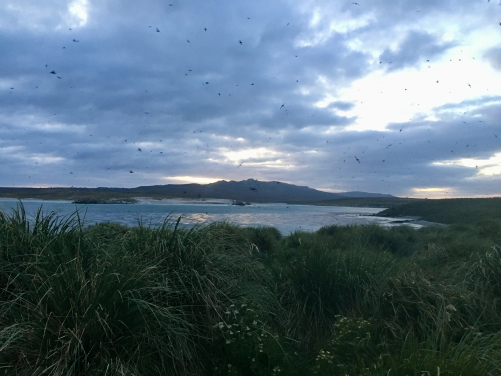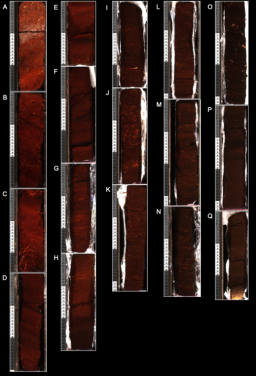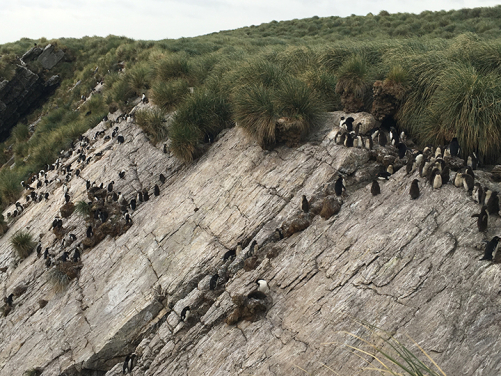Media
New study finds seabirds' response to abrupt climate change 5,000 years ago transformed sub-Antarctic island ecosystems
01 Nov 2020

At dusk, thousands of seabirds called sooty shearwaters (Ardenna grisea) return to
their deep nesting burrows dug into the peat of the tussac grassland at the Kidney Island National Nature Reserve, Falkland Islands. (Photo courtesy: Dulcinea Groff)

A rookery of black-browed albatross (Thalassarche melanophris) nest at a windy, exposed tussac grassland on West Point Island, Falkland Islands.
(Photo courtesy: Dulcinea GROFF)

Composite images of peat core from Surf Bay, Falkland Islands. The 476 cm core was
collected and transported as 17 monoliths pictured in A-Q. (Photo courtesy: Dulcinea V. Groff)
On a summer day, a Magellanic penguin (Spheniscus magellanicus) rests on a pedestal outside of their burrow in the peat of the tussac grassland, East Falkland Island, Falkland Islands. (Photo courtesy: Dulcinea GROFF)

A rookery of Southern rockhopper penguins (Eudyptes chrysocome chrysocome) nest between a rocky slope and a tussac grassland and bring in nutrients from the ocean directly to the grasses at the Kidney Island National Nature Reserve, Falkland Islands. (Photo courtesy: Dulcinea GROFF)
In the Falkland Islands, tussac grasslands that form deep peat deposits can be found eroding along some coastlines. (Photo courtesy: Dulcinea GROFF)
- 1 / 6
- 2 / 6
- 3 / 6
- 4 / 6
- 5 / 6
- 6 / 6
The Falkland Islands are a South Atlantic refuge for some of the world’s most important seabird species, including five species of penguins, Great Shearwaters, and White-chinned Petrels. In recent years, their breeding grounds in the coastal tussac (Poa flabellata) grasslands have come under increasing pressure from sheep grazing and erosion. And unlike other regions of the globe, there has been no long-term monitoring of the responses of these burrowing and ground nesting seabirds to climate change.
A 14,000-year paleoecological reconstruction of the sub-Antarctic islands done by an international research team led by The University of Maine (UMaine) including Dr Moriaki YASUHARA from the School of Biological Sciences and The Swire Institute of Marine Science, The University of Hong Kong (HKU), has found that seabird establishment occurred during a period of regional cooling 5,000 years ago. Their populations, in turn, shifted the Falkland Island ecosystem through the deposit of high concentrations of guano that helped nourish tussac, produce peat and increase the incidence of fire. The findings were recently published in the journal Science Advances.
Nutrient inputs from seabirds
“This terrestrial-marine link is critical to the islands’ grasslands conservation efforts going forward,” says Dulcinea GROFF, who led the research as a PhD student in UMaine. “The connection of nutrients originating in the marine ecosystem that are transferred to the terrestrial ecosystem enrich the islands’ nutrient-poor soil, thereby making the Falkland Islands sensitive to changes in climate and land use.
“Our work emphasizes just how important the nutrients in seabird poop are for the ongoing efforts to restore and conserve their grassland habitats. It also raises the question about where seabirds will go as the climate continues to warm,” said Groff, who conducted the research in the Falkland Islands during expeditions in 2014 and 2016 led by Jacquelyn GILL, an Associate Professor of paleoecology and plant ecology in the UMaine Climate Change Institute.
The UMaine expedition team collected a 476-centimeter peat column from Surf Bay, East Falkland. The 14,000-year record revealed in the undecomposed tussac leaves of the peat column captures the development of a terrestrial-marine linkage that supports some of the most important breeding colonies of seabirds in the Southern Ocean today.
The absence of seabirds at the East Falklands site prior to 5,000 years ago suggests that seabirds may be sensitive to warmer mediated sea surface temperatures, which can impact their food supply, according to the research team. With a warming South Atlantic today, the question is whether the Falkland Islands, about 300 miles east of South America, will continue to be a seabird breeding “hot spot”. The research team suggests that as the Southern Ocean continues to warm in the coming decades, the Falkland Islands seabird communities may undergo abrupt turnover or collapse, which could happen on the order of decades.
The 14,000-year record from East Falkland revealed that for 9,000 years before the arrival of seabirds, the region was dominated by low levels of grasses, a heathland of ferns and dwarf Ericaceous shrubs. About 5,000 years ago, the researchers says, an “abrupt transition” appears to occur. Concentrations in bio-elements such as phosphorus and zinc increase. Grass pollen accumulation rates skyrocket, indicating the establishment of tussac grasslands within 200 years of the establishment of seabird colonies on the island. Also found in the core: increased accumulation rates of peat and charcoal. “This timing is consistent with that of the Southern Ocean cooling that known paleoclimatic records consistently indicate.”, said Yasuhara, a paleoecologist and paleoclimatologist in HKU, who is familiar with polar paleoclimatology and paleoceanography.
It is clear that the addition of seabird populations bringing nutrients from the marine environment to the island drove changes in the terrestrial plant community structure, composition and function, as well as increased fire activity and nutrient cycling. What remains unclear is what drove the abrupt ecosystem shift, including the impacts of climate change and extinction, and the geographical distribution of living things through space and time.
“Our study is also a powerful reminder of why we need to understand how different ecosystems are connected as the world warms,” says Gill. “Such understanding is especially important in polar regions and ecosystems that are known to be sensitive to climate change,” continues Yasuhara. Gill concluded, “We know that many seabirds in the South Atlantic rely on these unique coastal grasslands, but it turns out that the grasses also depend on the nutrients seabirds provide. Because they rely on ecosystems in the ocean and on land for their survival, seabirds are really excellent sentinels of global change. We just don’t have good long-term monitoring data for most of these species, so we don’t know enough about how sensitive they are to climate change. The fossil record can help us fill in the gaps.”
Link of the journal paper: https://advances.sciencemag.org/content/6/43/eabb2788
Images download and captions: https://www.scifac.hku.hk/press
For media enquiries, please contact Ms Casey To, External Relations Officer of HKU Faculty of Science (tel: 3917 4948; email: caseyto@hku.hk) , Ms Cindy Chan, Assistant Director of Communications (tel: 3917 5286; email: cindycst@hku.hk).
